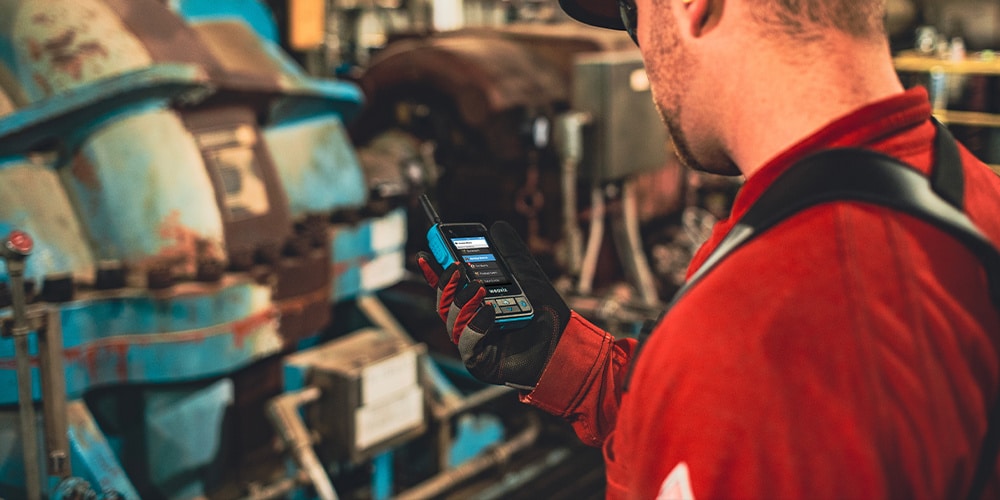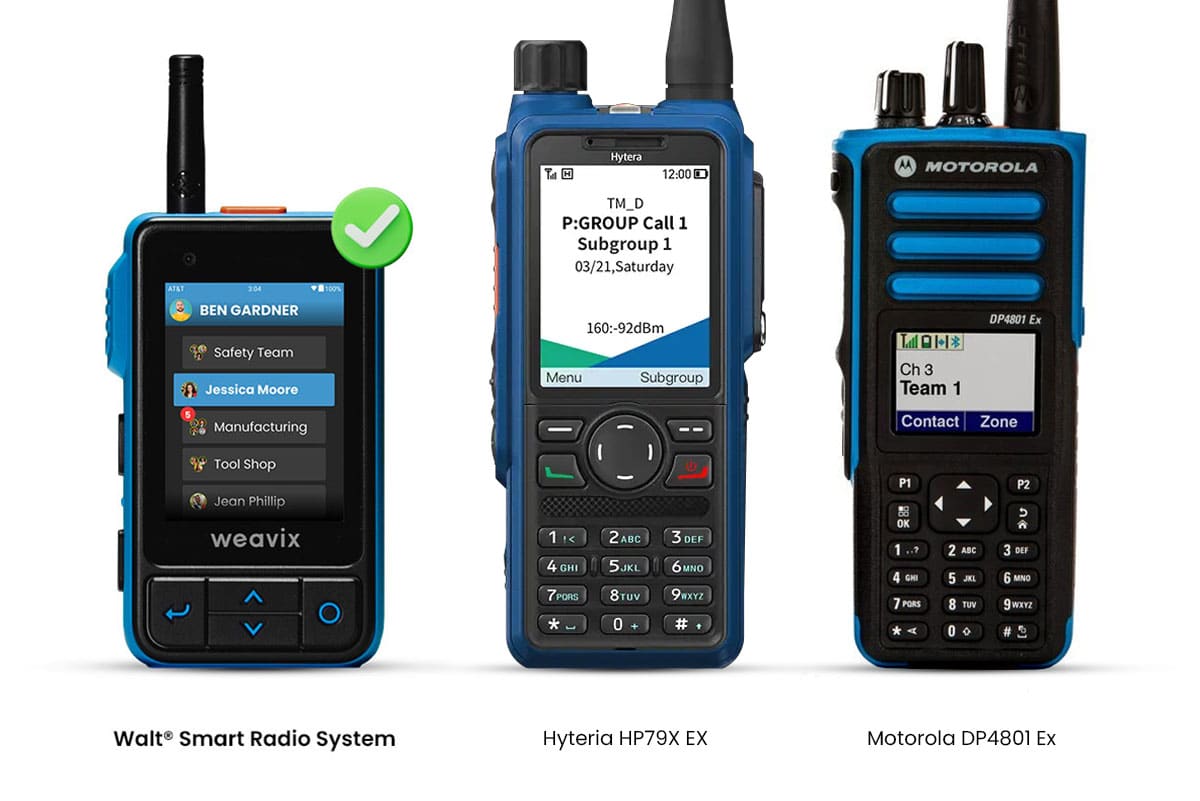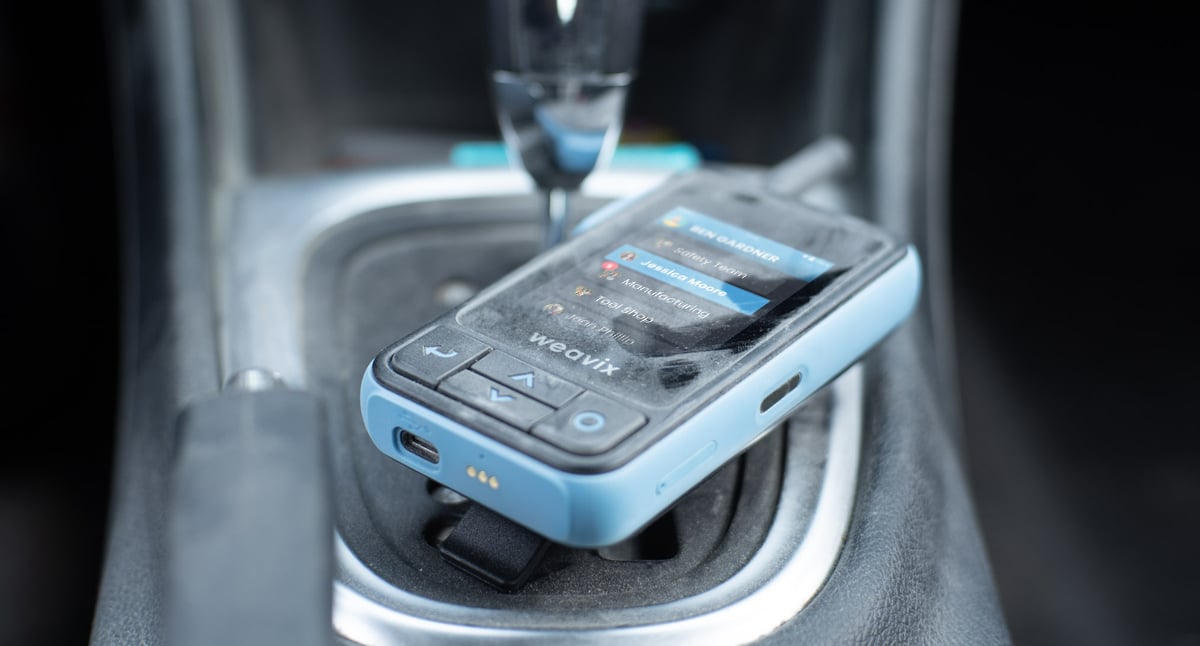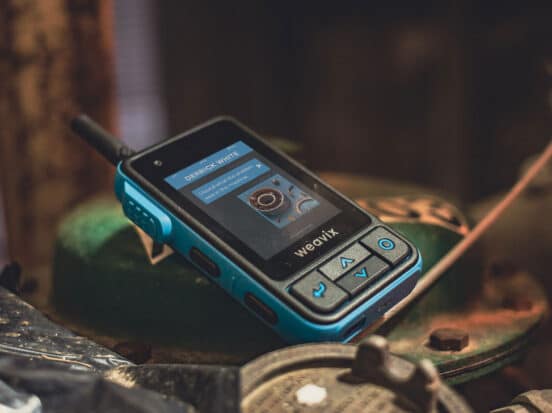Frontline teams in oil refineries, chemical plants, and other hazardous environments face more than just tough conditions — they risk disaster when electrical equipment sparks or overheats near flammable substances.
Conventional radios can pose real dangers in explosive atmospheres, leaving workers vulnerable and compliance at risk if they fail to prevent ignition. An intrinsically safe two-way radio addresses this threat by ensuring communications equipment cannot ignite hazardous materials, helping workers stay both connected and protected.
In this guide, you’ll learn what defines an intrinsically safe radio, which industries rely on this technology, key safety features to look for, and why a certified device like the Walt® Smart Radio System by weavix® is essential for frontline protection.
>>See how the Walt smart radio system works.
Key highlights:
- An intrinsically safe radio is a communication device engineered to prevent sparks or heat that could ignite flammable gases, vapors, or dust in hazardous environments.
- Intrinsically safe radios are required in industries such as oil and gas, chemical processing, and mining to protect workers and maintain compliance.
- Certified accessories — including batteries, microphones, and headsets — must also be intrinsically safe to ensure full protection for workers.
- The Walt® Smart Radio System by weavix® sets a new standard by combining rugged durability, advanced safety alerts, and AI-powered translation in one intrinsically safe device.
What Does “Intrinsically Safe” Mean in Radio Communications?
“Intrinsically safe” in radio communications means the device is designed so as not to ignite flammable gases, vapors, or dust. In industries such as oil and gas, chemical processing, and mining, this characteristic makes intrinsically safe radios important for protecting workers in areas where explosive materials may be present.
These radios are part of the broader category of intrinsically safe equipment, which includes sensors, lighting, and other tools engineered to operate safely in hazardous environments.
To achieve intrinsic safety, radios implement several technologies, such as:
- Circuit design that limits current and voltage to safe levels.
- Component selection using parts that won’t generate dangerous heat or sparks.
- Protective barriers such as zener diodes or galvanic isolation, reducing the energy released in case of circuit failure.
Accessories — like batteries, headsets, and remote microphones — must also meet the same safety requirements. Standards such as IEC 60079, ATEX (Europe), and regulations from entities like Factory Mutual (United States) govern certifications for intrinsically safe radios.
Keep reading: Why traditional communication systems can’t see what’s sinking your manufacturing operations

Benefits of an Intrinsically Safe Two-Way Radio for the Frontline
An intrinsically safe two-way radio allows workers to communicate in hazardous environments without creating ignition risks. As more companies recognize this need, the global intrinsically safe radios market was valued at $1.2 billion in 2023 and is expected to reach $2.3 billion by 2032, growing at 7.2% annually. This growth is driven by stricter workplace safety regulations and the need for reliable tools that keep workers safe while maintaining compliance.
The overall benefits of intrinsically safe two-way radios include:
- Enhanced safety in hazardous environments: Intrinsically safe radios limit electrical and thermal energy, preventing ignition of flammable gases, vapors, or dust. This keeps workers safe in high-risk settings like oil and gas, chemical manufacturing, and mining.
- Regulatory compliance: These radios meet certifications like ATEX and IECEx, helping organizations maintain compliance and avoid fines or shutdowns due to safety violations.
- Exceptional durability and reliability: Built to survive harsh environments with features like high ingress protection (such as IP68), these radios resist water, dust, and rough handling.
- Advanced worker protection features: Safety alarm features such as man-down, lone worker, and emergency alerts enable real-time response to accidents, improving outcomes in emergencies.
- Clear, secure communication: These devices deliver crystal-clear audio in noisy settings and often support advanced encryption, keeping sensitive information secure and frontline teams coordinated.
>>>Go deeper – Learn the definition of Class 1 Div 2.
How Can Intrinsically Safe Devices Protect Workers on the Job Site?
Intrinsically safe devices protect workers on the job site by ensuring their electrical and thermal outputs are always below ignition thresholds, even under fault conditions. This engineering keeps the risk of fires or explosions to an absolute minimum.
Key features found in intrinsically safe radios that improve safety and compliance include:
- Explosion-proof certification: Radios are certified according to hazardous zone classifications and meet international and regional safety standards.
- Safe battery technology: Robust battery management prevents accidental discharge or overheating.
- High-quality audio: Clear, reliable communication in noisy industrial environments keeps teams informed and coordinated.
- Safety alarms: Man-down, lone worker, and emergency alerts help supervisors respond quickly to potential incidents.
- Ingress protection: Devices are often IP68-rated, offering resistance to dust, moisture, and impacts.
While these features are essential across the category, the Walt® Smart Radio System by weavix® goes further by adding advanced worker protection capabilities designed specifically for frontline safety. These include:
| Feature | Function in Walt® Intrinsically Safe Radios |
|---|---|
| Man-Down System | Detects if a worker falls or is unresponsive and sends an automatic alert for rapid response |
| Workforce Danger Alert System | Enables workers to send immediate, critical distress signals in emergencies |
| Muster Location Monitoring | Tracks workers during emergency evacuations, ensuring everyone is accounted for |
| AI-Powered Language Translation | Supports real-time communication among diverse crews, removing language barriers on dangerous job sites |
Keep reading: Discover how Walt by weavix solves classic workplace communication barriers

What Are the Best Intrinsically Safe Radios?
Choosing the best intrinsically safe radio depends on industry requirements and safety needs. Here are the leading intrinsically safe communication devices that set the standard for hazardous environments:
1. Walt Smart Radio System
The Walt Smart Radio System by weavix is engineered to exceed the demands of frontline communication in the toughest, most hazardous environments.
Walt delivers advanced safety features, AI-powered collaboration, and robust durability to connect and protect every worker. Its built-in man-down and workforce danger alert systems, rugged waterproof construction, and AI language translation are all made for safe, simple use in oil and gas, chemical, and manufacturing operations.
| Key Features | Benefits | Strengths | Use Cases | Industries that benefit most |
|---|---|---|---|---|
| Durable, waterproof build | Long life in extreme conditions | Highest ruggedness and reliability | Hazardous area communications, emergency | Oil and gas, chemical manufacturing, mining |
| Man-down and safety alerts | Enhances incident response and safety compliance | Comprehensive integrated safety features | Evacuation, lone worker monitoring | Energy, utilities, manufacturing |
| AI language translation | Breaks down language barriers for diverse workforces | Seamless, real-time communication across teams | Multilingual sites, global operations | Industrial, construction, infrastructure |
2. Hytera HP79X EX
The Hytera HP79X EX offers high audio clarity, robust battery life, and MIL-STD-810H/IP68-rated durability, making it a strong choice for explosive atmospheres. It is certified for hazardous locations and features lone worker, man-down, and location-based services. However, this model is often priced higher than similar radios and requires additional accessories for full intrinsic safety compliance.
| Key Features | Benefits | Strengths | Use Cases | Limitations |
|---|---|---|---|---|
| Rugged, certified construction | Withstands dust, water, and shock | High-end build quality | Mining, oil and gas, heavy industry | Higher cost, accessory certification needed |
| Long battery life | Covers long shifts in remote or underground sites | Extended operation | High-risk maintenance and response | Price and accessory requirements can impact ROI |
| Advanced safety alarms | Ensures rapid response for lone or downed workers | Response speed | Worker monitoring |
Walt outperforms Hytera by seamlessly combining advanced safety functions, AI translation, and rugged design without the need for external accessories to maintain certifications.
3. Motorola DP4000 Ex Series
The Motorola DP4000 Ex Series meets IP67 and MIL-STD-810 requirements with high reliability and safety features like lone worker, man-down, and GPS. Intelligent Audio automatically adjusts volume, and the orange emergency button offers quick safety activation. However, this intrinsically safe walkie-talkie is notably heavier than its peers, which can lead to fatigue during long shifts, and not all workplace accessories are intrinsically safe by default.
| Key Features | Benefits | Strengths | Use Cases | Limitations |
|---|---|---|---|---|
| Intelligent Audio and safety alarms | Maintains clarity and quick emergency response | Clear communications | Chemical, oil and gas | Weight/ergonomics concerns, accessory limits |
| GPS and lone worker protection | Tracks worker safety and locations | Comprehensive compliance | Site-wide safety logistics | Not all accessories are intrinsically safe |
| High ingress protection | Resistant to tough environmental hazards | Strong durability | Explosive atmosphere sites |
The Walt Smart Radio System surpasses the DP4000 Ex Series with lighter, user-friendly design, always-on translation, and full-system safety certifications.
When choosing an intrinsically safe radio, always consider the specific requirements for your environment, relevant certifications, and whether the device’s full ecosystem — including accessories — meets necessary safety standards.
Get to know the best walkie-talkie for businesses.

Intrinsically Safe Communication Made Simple With Walt Smart Radio System
The Walt Smart Radio System by weavix sets the new standard for intrinsically safe communication devices by delivering an all-in-one platform with rugged durability, advanced worker safety solutions, and seamless translation for diverse frontline teams. Walt keeps your people connected, protected, and compliant in even the harshest environments, while simplifying device deployment and management.
With features like integrated man-down alerts, workforce danger systems, AI-powered language translation, and waterproof construction, Walt is ready for the job sites that demand reliability most. Discover how Walt can elevate your team’s safety and productivity — contact us to schedule a live demo or discuss tailored solutions for your hazardous workplace.
Frequently Asked Questions
Why are intrinsically safe radios necessary in hazardous industries?
Intrinsically safe radios are necessary in hazardous industries because they prevent the risk of explosions caused by electrical sparks or heat from conventional devices. In sectors like oil and gas, mining, and chemical manufacturing, where flammable gases, vapors, or dust are present, even minor electrical faults can lead to catastrophic incidents.
Intrinsically safe toolsensure absolute safety by keeping all electrical and thermal energy below ignition thresholds. This protects workers, ensures compliance with regulatory requirements, and promotes reliable team communication in the most demanding environments.
How do intrinsically safe radios differ from standard two-way radios?
The key difference is that intrinsically safe radios are engineered to contain any possible spark or heat source that could ignite hazardous substances, whereas standard two-way radios do not have these designs or certifications.
Intrinsically safe devices use specialized circuit designs, components, and protective barriers, and undergo rigorous third-party certification. Their accessories, such as batteries and microphones, are also certified, making them the safe choice in regulated or high-risk workplaces.
What are the most important features to look for in an intrinsically safe walkie-talkie?
The most important features to look for in an intrinsically safe walkie-talkie include:
- Internationally recognized certifications (ATEX, IECEx, FM)
- Clear labeling for hazardous area use
- Rugged and waterproof construction
- Battery safety management
- Essential safety alarms such as man-down and workforce danger alerts.
Additional capabilities such as GPS, lone worker protection, and AI-powered language translation — available on solutions like the Walt Smart Radio System — further increase safety and operational effectiveness for multilingual teams.
Must all accessories be intrinsically safe too?
Yes, all accessories — including batteries, remote speaker microphones, headsets, and chargers — that connect to an intrinsically safe radio must also be certified intrinsically safe. Using uncertified accessories can compromise the entire system, create new sources of ignition, and void certifications. It is critical to choose only certified accessories to ensure full protection and guarantee compliance in hazardous work environments.


